What Animal Is Mark Twain Depicted As
The Venus of Urbino painting was produced by Titian from Italy in about 1534. Titian's Venus of Urbino painting portrayed a naked young female person, typically associated with Venus the Goddess, and posed reclining on a bed. The Renaissance women painting is based on the Dresden Venus which was created by Giorgione. In this article, we will detect the Venus of Urbino's meaning and the method of its creation. The Venus of Urbino analysis will reveal much about the painting that is peradventure not that articulate or obvious on showtime viewing.
Table of Contents
- 1 Titian's Venus of Urbino Painting
- 1.1 The Artist Behind the Venus of Urbino Painting: Titian
- 2 A Venus of Urbino Analysis
- 2.1 Later History
- iii Frequently Asked Questions
- 3.1 Who Created the Famous Renaissance Woman Painting, the Venus of Urbino?
- iii.two What Is the Venus of Urbino Pregnant?
Titian'southward Venus of Urbino Painting
The stance of the effigy is modeled on the Dresden Venus, which is typically credited to Giorgione and for which Titian is said to have produced the background landscape. Titian has tamed Venus in this representation by relocating her to an interior location, connecting her with the audience, and making her sexuality plain; some even claim the figure in the Renaissance woman painting is masturbating.
NearVenus of Urbino analyses fall into two camps; both agree that information technology has a strong sensual charge, but apart from that, it is viewed as either a portrait of a prostitute, maybe Zaffetta, or as a painting commemorating the marriage of its initial owner – who, claimed by many, did non commission it.
This topic is office of a wider contend regarding the relevance of the reclined nude female style, which Titian adult or helped create with Giorgione's "Dresden Venus" of around 1510.
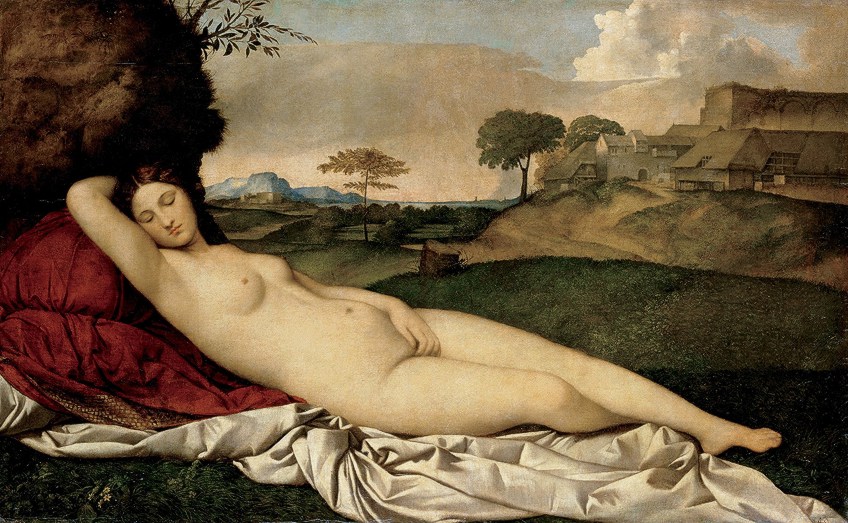 Dresden Venus (or Sleeping Venus) (c. 1510) by Giorgione;Giorgione, Public domain, via Wikimedia Commons
Dresden Venus (or Sleeping Venus) (c. 1510) by Giorgione;Giorgione, Public domain, via Wikimedia Commons
"It has all the same to be demonstrated that the most renowned representative of this blazon, Titian'due south Venus of Urbino, is anything less than a motion-picture show of a lovely naked lady on a bed, devoid of traditional or fifty-fifty metaphorical substance," writes Charles Promise. Even Edgar Air current, a relentless researcher of metaphor rooted in Renaissance Neoplatonism, had to admit that in this instance, "an overt eroticism had finally demolished the Platonic comparisons."
The Artist Behind the Venus of Urbino Painting: Titian
| Nationality | Italian |
| Engagement of Nascence | c. 1490 |
| Date of Death | 27 August 1576 |
| Identify of Birth | Pieve di Cadore, Italian republic |
| Associated Motion | Italian Renaissance |
Titian was a well-known Renaissance creative person who merged Loftier Renaissance and Mannerism elements to produce a far-ahead-of-its-fourth dimension technique. He occupied Venetian fine art with a level of creativity that permitted the city to compete with the preexisting artistic centers of Rome and Florence, and he produced portraits of some of the near essential and prominent personas of the catamenia, including, Pope Paul III, Charles V, Philip Two of Spain, and Henry Three of France. In addition to portraiture, he produced a broad range of theological and mythological subjects, typically on a large scale.
Throughout his long and productive career, his piece of work evolved from typical Renaissance iconography to increasingly frenetic paintings that abandoned harmonious compositions in favor of disproportion and dynamic topics. As he approached the terminate of his life, his works became darker and more impressionistic.
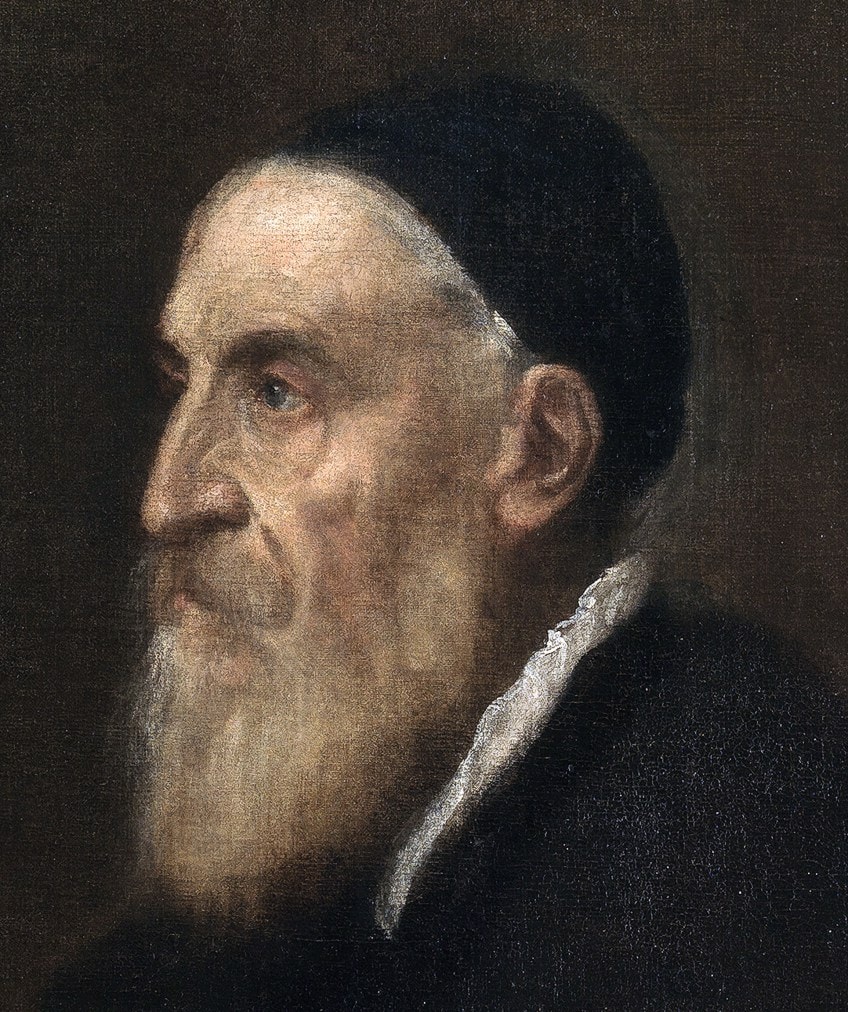 A shut-up of a self-portrait past Titian, c. 1562; Titian, Public domain, via Wikimedia Commons
A shut-up of a self-portrait past Titian, c. 1562; Titian, Public domain, via Wikimedia Commons
He had a tremendous outcome on his peers, and his works may be viewed as early pioneers of the trigger-happy struggle of Baroque art, as well every bit influencing succeeding creatives. Titian was well recognized for his dramatic use of color, specially in his initial studies, which he did past seeking out rare colors and using them in their purest and well-nigh extreme form, as well as precisely harmonizing each colour with those around it to make a cohesive overall image. He also concentrated on the effect of light on color, using lighting techniques such every bit chiaroscuro to accentuate contrasting colors.
Through this concentration, he established a separation betwixt Florentine and Venetian art.
Whereas Renaissance artists in Florence and Rome stressed line, Titian led the Venetian Renaissance method, which was marked by color. Subsequently work by the painter is distinguished by free brushwork and an emotive utilise of pigment, and it is believable that he employed his fingertips in addition to brushes to disperse and blend pigment at occasions.
Titian's method of painting adult a fluidity that added a feeling of move and passion to his artwork and set him apart from his contemporaries. Titian worked near entirely with oils, which was a novel medium at the time. The material immune him to layer a sequence of glazes to capture the visual event of the human figure with new precision, effeminateness, and softness. This realism was nigh visible in his portrayals of feminine nakedness, which were unusually sexually graphic for the period and appear to reflect Titian's inner desires.
 Venus Rising from the Ocean ("Venus Anadyomene") (1520) by Titian; Titian, Public domain, via Wikimedia Commons
Venus Rising from the Ocean ("Venus Anadyomene") (1520) by Titian; Titian, Public domain, via Wikimedia Commons
Titian'southward Mannerism style influenced a multitude of his colleagues, notably those who worked in his workshop, such as Bonifazio Veronese, Paris Bordone, and Polidoro da Lanciano, as well as his nephew Marco Vecellio. Information technology has as well been reported that in his later years, he worked with El Greco, who influenced his notably brilliant utilize of color. Titian was dubbed "the dominicus amidst footling stars not merely among the Italians only amidst all the painters of the world" by art historian Giovanni Lomazzo in 1590, and masters such as Rembrandt, Rubens, and Tintoretto owe a tribute to Titian in respect of blueprint, color, and use of loose brushstrokes.
This effect lasted far into the seventeenth century, with Marco Boschini commenting over a century after Titian's expiry in 1674 that "Titian genuinely was the most wonderful of those who decorated: because his brushes constantly gave birth to manifestations of life."
A Venus of Urbino Analysis
| Year Completed | c. 1534 |
| Medium | Oil on Sail |
| Dimensions | 119 cm x 165 cm |
| Current Location | Uffizi, Florence |
Venus looks straight at the observer, unconcerned near her nakedness. She has a posy of flowers in her right hand and her other paw is over her genitals. A dog, which is commonly used equally a symbol of faithfulness, may be seen in the background. Ii maids are depicted in the backdrop searching through a cassone body, where garments were stored.
Titian's representation of the internal surround is remarkable, if non unique.
 Venus of Urbino (c. 1534) by Titian; Titian, Public domain, via Wikimedia Commons
Venus of Urbino (c. 1534) by Titian; Titian, Public domain, via Wikimedia Commons
Titian was hired by Pope Clement Seven to paint the 21-year-old Ippolito de' Medici, who was grudgingly named a cardinal (but not a priest) by his uncle. He was a papal ambassador who was attempting to pursue a armed services career. On the 20th of October, 1532, he stayed the evening in Venice with Angela del Moro, besides known as Angela Zaffetta, a renowned prostitute in Venice who was occasionally a dinner companion of Aretino and Titian, the latter of whom was a friend of the cardinal.
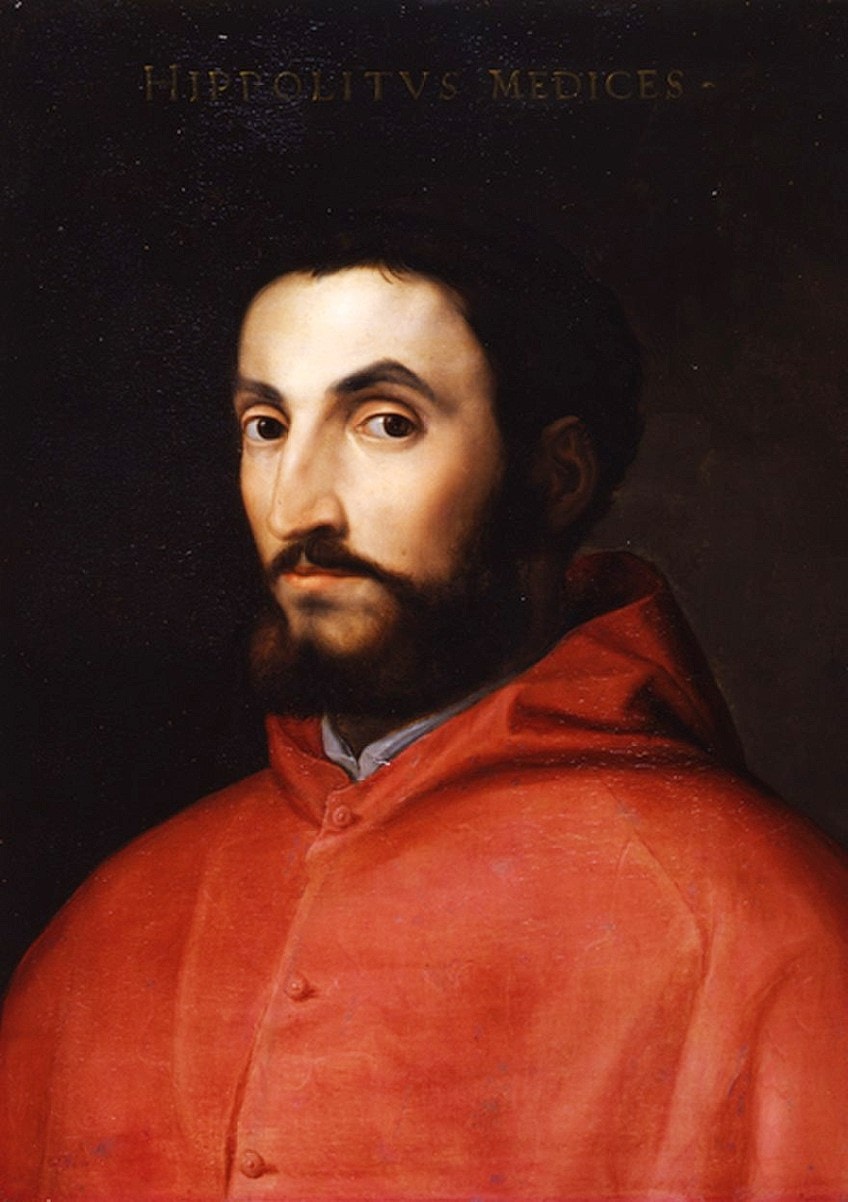 Primal Ippolito de' Medici (earlier 1605) past Cristofano dell'Altissimo;Cristofano dell'Altissimo, Public domain, via Wikimedia Eatables
Primal Ippolito de' Medici (earlier 1605) past Cristofano dell'Altissimo;Cristofano dell'Altissimo, Public domain, via Wikimedia Eatables
Titian painted Ippolito's picture, and it is likely that he was ordered to include a nude painting of Angela Zaffetta, or that Titian produced one in the hope that he would appreciate it. Titian had written to Ippolito'south secretarial assistant in Rome on the 20th of Dec, 1534, stating that he had been engaged in a moving picture of a female for the cardinal.
Ippolito passed away in August 1535 and presumably never saw the picture show, which was still in Titian's workshop when Guidobaldo Ii della Rovere came to pose for a painting in January 1538.
As correspondence from him and his mother demonstrate, Rovere was eager to purchase it and did so many months afterwards; he alludes to it but as "the naked woman," and was concerned Titian might sell it to somebody else. Later that twelvemonth, upon his male parent'south death, he received the Duchy of Urbino, which is an expanse ruled over by a Duke, giving ascension to the painting'due south mutual proper noun, just it appears that it was largely kept in Pesaro from the start.
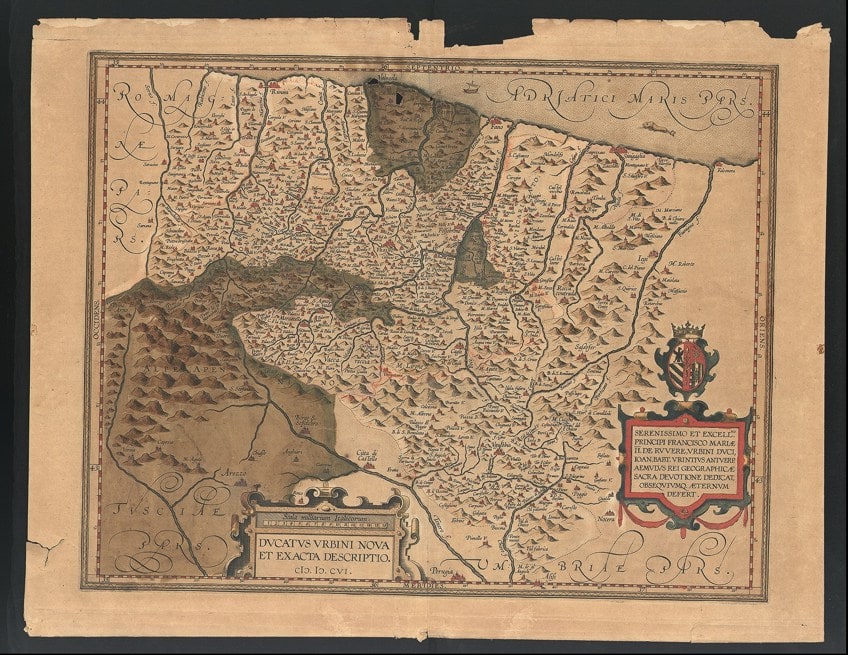 A map of Duchy of Urbino, 1608;Abraham Ortelius, Public domain, via Wikimedia Commons
A map of Duchy of Urbino, 1608;Abraham Ortelius, Public domain, via Wikimedia Commons
Instead, the picture might have been ordered past Guidobaldo, perhaps to commemorate his wedding in 1534 to Giulia Varano, which elevated him to Duke of Camerino. Some commentators have seen union allusions in elements such as the attendants at the cassone, where the garments traditionally provided to the helpmate by her husband's family were housed.
Venus' hand "caressing" her genital expanse, co-ordinate to Rona Goffen, is such an allusion since it was initially believed that a female person "emission" or orgasm was required for pregnancy to occur, and female masturbation was thus permitted only in circumstances when the male had ejaculated and retreated. In elite marriages, the development of heirs was a major consequence.
Fifty-fifty the tiny dog on the mattress has been introduced into the contend.
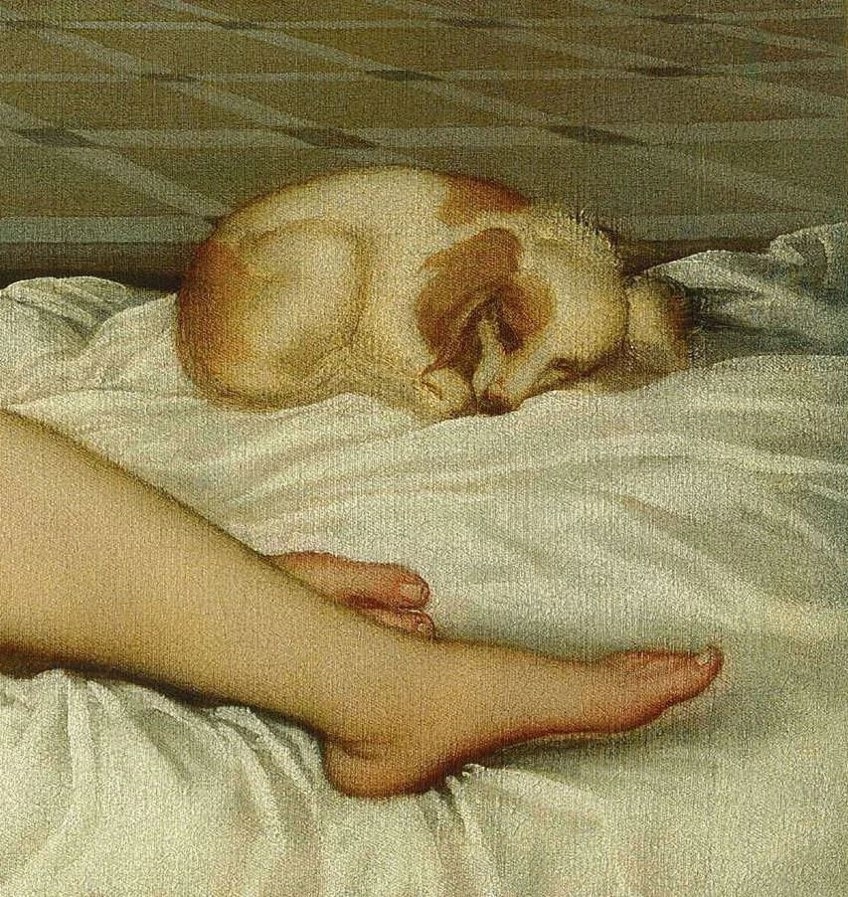 A item of Titian'southward Venus of Urbino (c. 1534);Uffizi, Public domain, via Wikimedia Commons
A item of Titian'southward Venus of Urbino (c. 1534);Uffizi, Public domain, via Wikimedia Commons
In fact, an identical domestic dog is depicted in Titian's painting of the duke'southward mother Eleonora Gonzaga, with the rationalization being that the dog helps to identify the business firm equally a della Rovere home, and the fact that it remains silent suggests that the observer is the woman's husband.
Co-ordinate to Józef Grabski's latest interpretation, the picture is a metaphor of marital love between Fernando d'valos and Italian poet Vittoria Colonna. Grabski backs up his theory with visual prove and symbols, the almost notable of which is the traditional colonnade in front of the trees in the opening on the right side, a little element in the picture that mimics the Colonna Family unit shield of artillery.
Later History
The della Rovere dynasty moved to Pesaro, where the painting was exhibited at the Villa Imperiale, while the Papacy proceeded to entirely transfer the duchy to the Papal States in 1624. When Vittoria della Rovere married Ferdinando Ii de' Medici, it was added to the Medici family library in 1633.
Information technology was relocated to the Uffizi in 1736 and has stayed there e'er since, with the exception of trips to exhibits in Brussels, Madrid, Tokyo, Venice, and Urbino in the 21st century.
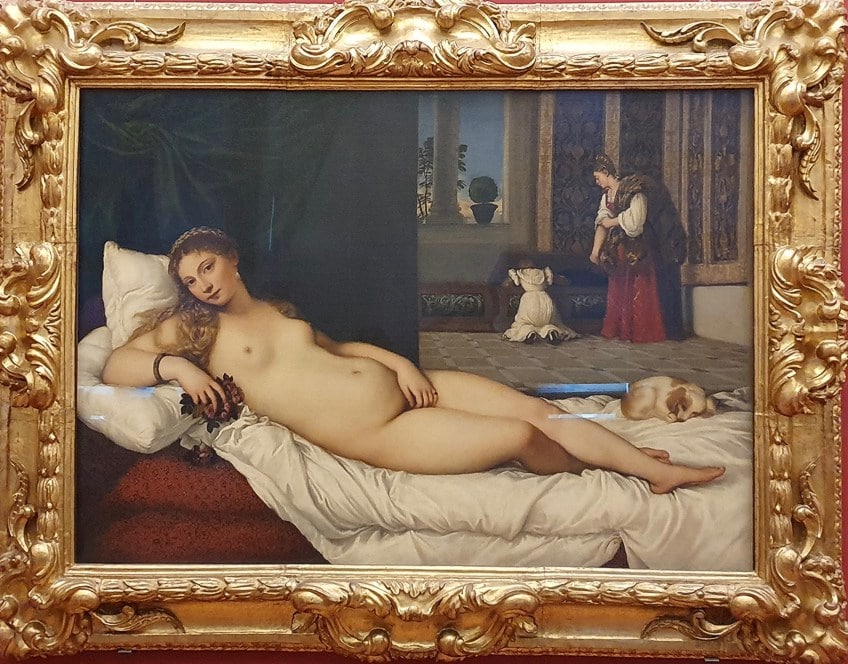 Titian'south Venus of Urbino (c. 1534) framed at the Uffizi Gallery in Florence, Italia; Yair Haklai, CC BY-SA 4.0, via Wikimedia Eatables
Titian'south Venus of Urbino (c. 1534) framed at the Uffizi Gallery in Florence, Italia; Yair Haklai, CC BY-SA 4.0, via Wikimedia Eatables
Mark Twain described the Venus of Urbino equally "the filthiest, nastiest, well-nigh obscene image the earth possesses" in his 1880 travelog "A Tramp Abroad". He speculated that "it was created for a brothel, and it was probably declined considering it was a touch on besides powerful," adding wryly that "in reality, information technology is a touch as well intense for any venue save a public art gallery."
Twain does this to contrast the creative liberty (for instance, nudity) permitted in painting with the constraints and Victorian morality put on literature in the "past eighty or 90 years." Twain similarly ridicules the fig leaves put on nude sculptures in Rome in the nineteenth century, which had "stood in naive nakedness for millennia" in the same paragraph.
Titian of Italy created the "Venus of Urbino" painting in about 1543. Titian's "Venus of Urbino" painting depicted a naked young female lying on a bed, which is generally linked with Venus the Goddess. "The Dresden Venus", painted by Giorgione, is the inspiration for the Renaissance lady's picture. Titian has tamed Venus in this prototype by moving her to the inside, uniting her with the audition, and emphasizing her sensuality; some fifty-fifty advise the figure in the Renaissance lady flick is masturbating.
Frequently Asked Questions
Who Created the Famous Renaissance Woman Painting, the Venus of Urbino?
Titian was a well-known artist of the Renaissance menses who combined High Renaissance and Mannerism concepts to create a style that was far alee of its time. He engaged Venetian painting with a degree of ingenuity that allowed the city to compete with the pre-existing creative centers of Rome and Florence, and he created portraits of some of the menses's most important and influential figures. He had a large outcome on his contemporaries, and his paintings may exist considered equally early forerunners of the tearing struggle of Baroque art, as well as influencing succeeding creatives.
What Is the Venus of Urbino Meaning?
Some observers have identified spousal relationship allusions in aspects such equally the attendants at the cassone, which traditionally stored the clothing handed to the bride by her husband's family. According to Rona Goffen, Venus'southward hand "caressing" her vaginal area is such an allusion since it was once thought that a female "emission" or orgasm was necessary for pregnancy to occur, and female masturbation was therefore permitted only when the male had ejaculated and fled. The creation of heirs was a primary business organization in aristocracy marriages. According to Józef Grabski's electric current interpretation, the paradigm is a metaphor for Fernando d'valos and Italian poet Vittoria Colonna'southward married love. Grabski supports his argument with visual evidence and symbols, the most prominent of which is the archetype pillar in front of the trees in the aperture on the right side, a trivial piece on the painting that resembles the Colonna Family shield of arms.
Source: https://artincontext.org/titian-venus-of-urbino/
Posted by: hagemanhimpre.blogspot.com

0 Response to "What Animal Is Mark Twain Depicted As"
Post a Comment